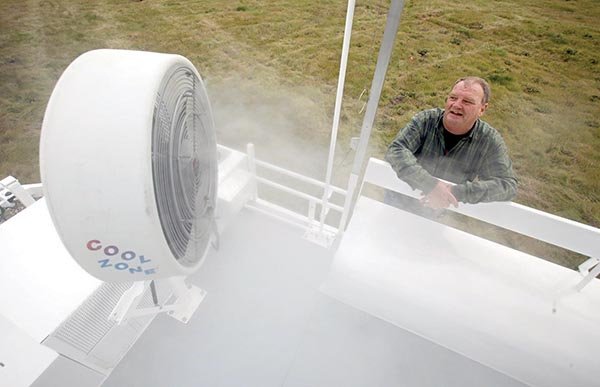SACRAMENTO, Calif. — After watching grape harvesters toil in the vineyards on a summer day without shade, Garth Patterson was inspired to get them some relief.
The Napa Valley businessman experimented with several prototypes before finding what he believes is the answer. He created a trailer with an aluminum canopy that provides first aid and relief from heat stress, a vehicle he hopes will improve farmworker safety while helping him turn a profit.
Patterson has trademarked his “Cooling Station,” which runs on a generator and features misting fans. It seats 12, holds up to 300 gallons of water and features an emergency shower.
“It has huge potential in farming, construction and emergency services,” said Patterson, a former fan distributor. “It allows them to sit in the shade and cool off.”
Patterson, 56, said he hopes to fill a need as California officials debate the best rules for protecting laborers from heat illness and death. The stations also could be sold in places like Florida and Texas, he said.
In May 2008, a pregnant teenager, Maria Vasquez Jimenez, died from heatstroke as she pruned grapevines for more than nine hours in nearly triple-digit heat. The death prompted Gov. Arnold Schwarzenegger and other California officials to call for stronger farmworker protections, but the effort since then has been uneven.
This year, inspectors found dozens of laborers working with little or no shade or water during a heat wave. Eight farm-labor contractors were shut down for violating heat illness-prevention rules.
Yet last summer the state Occupational Safety and Health Standards Board twice rejected emergency rules designed to prevent heat stress. Farmworker advocates wanted shade structures erected when temperatures reach 75 degrees, while farm owners wanted the regulation to kick in at 85 degrees. Construction firms also voiced concerns about how they might be affected by the new rules.
The state safety board is now putting the proposal through a full hearing.
The American Civil Liberties Union has sued the state on behalf of the United Farm Workers of America and five plaintiffs, most of whom have suffered heat illness or have had relatives die.
Since 2005, the California Division of Occupational Safety and Health has confirmed 12 cases of farmworkers dying from heat-related stress.
Patterson’s invention could be great news for those who work California’s fields, said Maria Machuca, spokesman for the United Farm Workers. She said the union will watch to see whether state regulators show similar enthusiasm.
Machuca noted that the state has not been able to enforce existing laws that are intended to ensure farmworkers get access to shade and cool water.
The California Division of Occupational Safety and Health would be glad to conduct an assessment of Patterson’s trailer if he contacts the agency, spokesman Erika Monterroza said.
Patterson characterizes his trailer is an “asset protection, too,” for businesses whose employees labor in the sun, because the penalties for failing to properly care for worker scan far outweigh the Cooling Station’s $20,000 price tag. He also is making sales pitches to homebuilders, emergency first responders and movie production crews.
Early models of the Cooling System consisted of chairs, a collapsible table and water jugs. When a local engineering firm built the third prototype, it was deemed too expensive.
Patterson finally settled on Zeiman Manufacturing in Rialto, east of Los Angeles, to make the current model.
The Cooling Station was named as one of the top 10 products of 2010 by World Ag Expo in Tulare County for its potential to advance agricultural production. Judges included farmers, ranchers and agribusiness professionals. It will be featured at the Feb. 9-11 expo, which attracts about 100,000 visitors each year.
Business, Pages 23 on 12/31/2009

